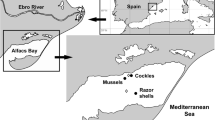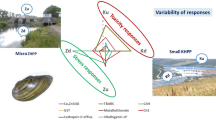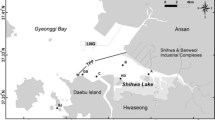Abstract
Transplanted Mytilus galloprovincialis and native Ruditapes philippinarum were deployed in 10 sampling stations with different pollution impact within the Lagoon of Venice to evaluate the temporal variations and the suitability of the following cytochemical and histochemical biomarkers just as indicators of environmental stress: lysosomal membrane stability, lipofuscins, neutral lipids and lysosome to cytoplasm volume ratio. The physiological status of the organisms was also investigated by determining the survival in air capability and the reburrowing rate (clams). The biological parameters were assessed in June and October. Furthermore, for a better definition of the environmental aspects of the study sites, heavy metal, PAH and PCB concentrations were also evaluated in the sediments. As a whole, the biological responses examined in both species from all the sampling sites showed significant differences between the two seasonal campaigns, only lysosomal membrane stability exhibited less variability. Pollutants in sediments generally showed low-intermediate contamination levels, few hotspots persisting mostly in the inner areas of the lagoon, the most influenced by the industrial zone. Transplanted mussels were more responsive than native clams and the biological responses of both species varied temporally. The range of the spatial variability was always narrow and reflected only partially the broader variability shown by the chemical content in the sediments. In this sense, biological responses seemed to be particularly influenced by the high temporal and spatial heterogeneity that characterise the Lagoon of Venice, as well as most of the transitional environments.
Similar content being viewed by others
References
Apitz, S. E., Barbanti, A., Bernstein, A. G., Bocci, M., Delaney, E., & Montobbio, L. (2007). The assessment of sediment screening risk in Venice lagoon and other coastal areas using international sediment quality guidelines. Journal of Soils and Sediments, 7, 326–341.
Apitz, S. E., Degetto, S., & Cantaluppi, C. (2009). The use of statistical methods to separate natural background and anthropogenic concentrations of trace elements in radio-chronologically selected surface sediments of the Venice Lagoon. Marine Pollution Bulletin, 58, 402–414.
Bancroft, J. D. (1967). An introduction to histochemical technique. London: Butterworth.
Bayne, B. L. (1976). Aspects of reproduction in bivalve molluscs. In M. Wiley (Ed.), Estuarine processes (Vol. 1, pp. 432–448). New York: Academic.
Bebianno, M. J., Geret, F., Hoarau, P., Serafim, M. A., Coelho, M. R., Gnassia-Barelli, M., et al. (2004). Biomarkers in Ruditapes decussatus: A potential bioindicator species. Biomarkers, 9, 305–330.
Bellucci, L. G., Frignani, M., Paolucci, D., & Ravanelli, M. (2002). Distribution of heavy metals in sediments of the Venice Lagoon: The role of the industrial area. Science of the Total Environment, 295, 35–49.
Bernardello, M., Secco, T., Pellizzato, F., Chinellato, M., Sfriso, A., & Pavoni, B. (2006). The changing state of contamination in the Lagoon of Venice. Part 2: Heavy metals. Chemosphere, 64, 1334–1345.
Bernardi Aubry, F., Berton, A., Bastianini, M., Socal, G., & Acri, F. (2004). Phytoplankton succession in a coastal area of the NW Adriatic, over a 10-year sampling period (1990–1999). Continental Shelf Research, 24, 97–115.
Blaise, C., Gagné, F., Pellerin, J., Hansen, P. D., & Trottier, S. (2002). Molluscan shellfish biomarker study of the Quebec, Canada, Saguenay Fjord with the soft-shell clam. Mya arenaria. Environmental Toxicology, 17, 170–180.
Borja, A., Josefson, A. B., Miles, A., Muxika, I., Olsgard, F., Phillips, G., et al. (2006). An approach to the intercalibration of benthic ecological status assessment in the North Atlantic ecoregion, according to the European water framework directive. Marine Pollution Bulletin, 55, 42–52.
Broeg, K., & Lehtonen, K. K. (2006). Indices for the assessment of environmental pollution of the Baltic Sea coasts: Integrated assessment of a multi-biomarker approach. Marine Pollution Bulletin, 53, 508–522.
Buchanan, J. B. (1984). Sediment analysis. In N. A. Holme & A. D. Mc Intyre (Eds.), Methods for the study of marine benthos (pp. 41–65). Oxford: Blackwell.
Cajaraville, M. P., Bebianno, M. J., Blasco, J., Porte, C., Sarasquete, C., & Viarengo, A. (2000). The use of biomarkers to assess the impact of pollution in coastal environments of the Iberian Peninsula: A pratical approach. Science of the Total Environment, 247, 295–311.
Cancio, I., Ibabe, A., & Cajaraville, M. P. (1999). Seasonal variations of peroxisomal enzyme activities and peroxisomal structure in mussels Mytilus galloprovincialis and its relationship with the lipid content. Comparative Biochemistry and Physiology, 123C, 135–144.
Caselli, F., & Fabbri, E. (2005). Use of Mytilus galloprovincialis and Tapes philippinarum as sentinel organisms for the development of a biosurveillance program in the Pialassa Baiona coastal lagoon (Ravenna, Italy). Chemistry and Ecology, 21, 465–477.
Cravo, A., Lopes, B., Serafin, A., Company, R., Barreira, L., Gomes, T., et al. (2009). A multibiomarker approach in Mytilus galloprovincialis to assess environmental quality. Journal of Environmental Monitoring, 11, 1673–1686.
Da Ros, L., Bressan, M., & Marin, M. G. (1985). Reproductive cycle of the mussel (Mytilus galloprovincialis) in the Venice Lagoon (North Adriatic). Bollettino di Zoologia, 52, 223–229.
Da Ros, L., Nasci, C., Marigomez, I., & Soto, M. (2000). Biomarkers and trace metals in the digestive gland of indigenous and transplanted mussels, Mytilus galloprovincialis, in Venice Lagoon, Italy. Marine Environmental Research, 50, 417–423.
Da Ros, L., & Nesto, N. (2005). Cellular alterations in Mytilus galloprovincialis (Lmk) and Tapes philippinarum (Adams and Reeve, 1850) as biomarkers of environmental stress: Field studies in the Lagoon of Venice (Italy). Environment International, 31, 1078–1088.
Da Ros, L., Nesto, N., Nasci, C., Moschino, V., Pampanin, D., & Marin, M. G. (2003). Biochemical and behavioural effects of hydraulic dredging on the target species Chamelea gallina. Fisheries Research, 64, 71–78.
Dailianis, S., Domouhtsidou, G. P., Raftopoulou, E., Kaloyianni, M., & Dimitriadis, V. K. (2003). Evaluation of neutral red retention assay, micronucleus test, acetylcholinesterase activity and a signal transduction molecule (cAMP) in tissues of Mytilus galloprovincialis (L.), in pollution monitoring. Marine Environmental Research, 56, 443–470.
de Kock, W. C., & Kramer, K. J. M. (1994). Active biomonitoring (ABM) by translocation of bivalve molluscs. In K. J. M. Kramer (Ed.), Biomonitoring of coastal waters and estuaries (pp. 51–84). Boca Raton: CRC.
Dimitriadis, V. K., Domouhtsidou, G. P., & Cajaraville, M. P. (2004). Cytochemical and histochemical aspects of the digestive gland cells of the mussel Mytilus galloprovincialis (L.) in relation to function. Journal of Molecular Histology, 35, 501–509.
Eertmann, R. H. M., & de Zwaan, A. (1994). Survival of the fittest: Resistance of mussels to aerial exposure. In K. J. M. Kramer (Ed.), Biomonitoring of coastal waters and estuaries (pp. 269–282). Boca Raton: CRC.
Eertman, R. H. M., Wagenvoort, A. J., Hummel, H., & Smaal, A. C. (1993). “Survival in air” of the blue mussel Mytilus edulis L. as a sensitive response to pollution-induced environmental stress. Journal of Experimental Marine Biology and Ecology, 70, 179–195.
Frignani, M., Bellucci, L. G., Favotto, M., & Albertazzi, S. (2005). Pollution historical trends as recorded by sediments in selected sites of the Venice Lagoon. Environment International, 31, 1011–1022.
Galloway, T. S., Brown, R. J., Browne, M. A., Dissanayake, A., Lowe, D., Jones, M. B., et al. (2004). A multibiomarker approach to environmental assessment. Environmental Science and Technology, 38, 1723–1731.
Grbec, B., Vilibic, I., Bajic, A., Morovic, M., Paklar, G. B., Matic, F., et al. (2007). Response of the Adriatic Sea to the atmospheric anomaly in 2003. Annales Geophysicae, 25, 835–846.
Handy, R. D., Galloway, T. S., & Depledge, M. H. (2003). A proposal for the use of biomarkers for the assessment of chronic pollution and in regulatory toxicology. Ecotoxicology, 12, 331–343.
Hauton, C., Hawkins, L. E., & Hutchinson, S. (1998). The use of the neutral red retention assay to examine the effects of temperature and salinity on haemocytes of the European flat oyster Ostrea edulis (L.). Comparative Biochemistry and Physiology, 119B, 619–623.
Hedges, J. I., & Stern, J. H. (1984). Carbon and nitrogen determinations of carbonate-containing solids. Limnology and Oceanography, 29, 657–663.
Izagirre, U., Ramos, R. R., & Marigomez, I. (2008). Natural variability in size and membrane stability of lysosomes in mussel digestive cells: Seasonal and tidal zonation. Marine Ecology Progress Series, 372, 105–117.
Kaplan, E. L., & Meier, P. (1958). Nonparametric estimation from incomplete observations. Journal of the American Statistical Association, 53, 457–481.
Koukouzika, N., & Dimitriadis, V. K. (2005). Multiple biomarker comparison in Mytilus galloprovincialis from the Greek Coast: “Lysosomal Membrane Stability, Neutral Red Retention, Micronucleus Frequency and Stress On Stress”. Ecotoxicology, 14, 449–463.
Koukouzika, N., Raftopoulou, E. K., & Dimitriadis, V. K. (2009). Seasonal differences of lysosomal, lipid and lipofuscin parameters in the digestive gland of the mussel Mytilus galloprovincialis. Journal of Molluscan Studies, 75, 261–267.
Lasserre, P., & Marzollo, A. (2000). The Venice Lagoon ecosystem. Inputs and interactions between land and sea. Paris: UNESCO.
Long, E. R., MacDonald, D. D., Smith, S. L., & Calder, F. D. (1995). Incidence of adverse biological effects within ranges of chemical concentrations in marine and estuarine sediments. Environmental Management, 19, 81–97.
Lowe, D. M., Moore, M. N., & Clarke, K. R. (1981). Effects of oil on digestive cells in mussels: Quantitative alterations in cellular and lysosomal structure. Aquatic Toxicology, 1, 213–226.
Lowe, D. M., & Pipe, R. K. (1994). Contaminant induced lysosomal membrane damage in marine mussel digestive cells: An in vitro study. Aquatic Toxicology, 30, 357–365.
Marigomez, I., & Baybay-Villacorta, L. (2003). Pollutant-specific and general lysosomal responses in digestive cells of mussels exposed to model organic chemicals. Aquatic Toxicology, 64, 235–257.
Marigomez, I., Izagirre, U., & Lekube, X. (2005). Lysosomal enlargement in digestive cells of mussels exposed to cadmium, benzo[a]pyrene and their combination. Comparative Biochemistry and Physiology, 141C, 188–193.
Marin, M. G., Boscolo, R., Cella, A., Degetto, S., & Da Ros, L. (2006). Field validation of autometallographical black silver deposit (BSD) extent in three bivalve species from the Lagoon of Venice, Italy (Mytilus galloprovincialis, Tapes philippinarum, Scapharca inaequivalvis) for metal bioavailability assessment. Science of the Total Environment, 371, 156–167.
Marin, M. G., Nesto, N., & Da Ros, L. (2001). Evaluation of biological stress indices in Tapes philippinarum from the Lagoon of Venice, through monitoring of natural populations and transplantation experiments. In F. M. Faranda, L. Guglielmo, & G. Spezie (Eds.), Structures and processes in the Mediterranean ecosystem (pp. 91–94). New York: Springer.
Mauri, E., Poulain, P. M., & Notarstefano, G. (2008). Spatial and temporal variability of the sea surface temperature in the Gulf of Trieste between January 2000 and December 2006. Journal of Geophysical Research, 113, C10012. doi:10.1029/2007JC004537.
Meneghetti, F., Moschino, V., & Da Ros, L. (2004). Gametogenic cycle and variations in oocyte size of Tapes philippinarum from the Lagoon of Venice. Aquaculture, 240, 473–488.
Moore, M. N. (1988). Cytochemical responses of the lysosomal system and NADPH-ferrihemoprotein reductase in molluscan digestive cells to environmental and experimental exposure to xenobiotics. Marine Ecology Progress Series, 46, 81–89.
Moore, M. N., Allen, J. I., & McVeigh, A. (2006). Environmental prognostics: An integrated model supporting lysosomal stress responses as predictive biomarkers of animal health status. Marine Environmental Research, 61, 278–304.
Moore, M. N., Depledge, M. H., Readmana, J. W., & Leonard, D. R. P. (2004). An integrated biomarker-based strategy for ecotoxicological evaluation of risk in environmental management. Mutation Research, 552, 247–268.
Nasci, C., Da Ros, L., Nesto, N., Sperni, L., Passarini, F., & Pavoni, B. (2000). Biochemical and histochemical responses to environmental contaminants in clam, Tapes philippinarum, transplanted to different polluted areas of Venice Lagoon, Italy. Marine Environmental Research, 50, 425–430.
Nesto, N., Bertoldo, M., Nasci, C., & Da Ros, L. (2004). Spatial and temporal variations of biomarkers in mussels (Mytilus galloprovincialis) from the Lagoon of Venice, Italy. Marine Environmental Research, 58, 287–291.
Nesto, N., Romano, S., Moschino, V., Mauri, M., & Da Ros, L. (2007). Bioaccumulation and biomarker responses of trace metals and micro-organic pollutants in mussels and fish from the Lagoon of Venice, Italy. Marine Pollution Bulletin, 55, 469–484.
Orbea, A., Garmendia, L., Marigomez, I., & Cajaraville, M. P. (2006). Effects of the ‘Prestige’ oil spill on cellular biomarkers in intertidal mussels: Results of the first year of studies. Marine Ecology Progress Series, 306, 177–189.
Pampanin, D. M., Camus, L., Gomiero, A., Marangon, I., Volpato, E., & Nasci, C. (2005). Susceptibility to oxidative stress of mussels (Mytilus galloprovincialis) in the Venice Lagoon (Italy). Marine Pollution Bulletin, 50, 1548–1557.
Pearse, A. G. E. (1972). Histochemistry, theoretical and applied (Vol. 2). London: Churchill Livingstone.
Pearson, W. H., Woodruff, D. L., Sugarman, P. C., & Olla, B. L. (1981). Effects of oiled sediment on predation on the littleneck clam, Protothaca staminea, by the Dungeness crab, Cancer magister. Estuarine, Coastal and Shelf Science, 13, 445–454.
Petrovic, S., Semencic, L., Ozretic, B., & Ozretic, M. (2004). Seasonal variations of physiological and cellular biomarkers and their use in the biomonitoring of north Adriatic coastal waters (Croatia). Marine Pollution Bulletin, 49, 713–720.
Phelps, H. L. (1989). Clam burrowing bioassay for estuarine sediment. Bulletin of Environmental Contamination and Toxicology, 43, 838–845.
Regoli, F. (1992). Lysosomal responses as a sensitive stress index in biomonitoring heavy-metal pollution. Marine Ecology Progress Series, 84, 63–69.
Ringwood, A. H., Conners, D., & Hoguet, J. (1998). Effects of natural and anthropogenic stressors on lysosomal destabilization in oysters Crassostrea virginica. Marine Ecology Progress Series, 166, 163–171.
Secco, T., Pellizzato, F., Sfriso, A., & Pavoni, B. (2005). The changing state of contamination in the Lagoon of Venice. Part 1: Organic pollutants. Chemosphere, 58, 279–290.
Sobral, P., & Widdows, J. (1997). Effects of elevated temperatures on the scope for growth and resistance to air exposure of the clam Ruditapes decussatus (L), from southern Portugal. Scientia Marina, 61, 163–171.
Sokal, R. R., & Rohlf, F. J. (1981). Biometry. New York: Freeman.
UNEP/RAMOGE (1999). Manual on the biomarkers recommended for the MED POL biomonitoring programme. Athens: UNEP.
Veldhuizen-Tsoerkan, M. B., Holwerda, D. A., & Zandee, D. I. (1991). Anoxic survival time and metabolic parameters as stress indices in sea mussels exposed to cadmium or polychlorinated biphenyls. Archives of Environmental Contamination and Toxicology, 20, 259–265.
Viarengo, A., & Nott, J. A. (1993). Mechanisms of heavy metal cation homeostasis in marine invertebrates. Comparative Biochemistry and Physiology, 104C, 355–372.
Viarengo, A., Zannicchi, G., Moore, M. N., & Orunesu, M. (1981). Accumulation and detoxkation of copper by the mussel Mytilus galloprovinclalis Lam.: A study of the subcellular distribution in the digestive gland cells. Aquatic Toxicology, 1, 147–157.
Volpi Ghirardini, A., Arizzi Novelli, A., & Tagliapietra, D. (2005). Sediment toxicity assessment in the Lagoon of Venice (Italy) using Paracentrotus lividus (Echinodermata: Echinoidea) fertilization and embryo bioassays. Environment International, 3, 1065–1077.
Yunker, M. B., Macdonald, R. W., Vingarzan, R., Mitchell, R. H., Goyette, D., & Sylvestre, S. (2002). PAHs in the Fraser River basin: A critical appraisal of PAH ratios as indicators of PAH source and composition. Organic Geochemistry, 33, 489–515.
Zorita, I., Apraiz, I., Ortiz-Zarragoitia, M., Orbea, A., Cancio, I., Soto, M., et al. (2007). Assessment of biological effects of environmental pollution along the NW Mediterranean Sea using mussels as sentinel organisms. Environmental Pollution, 148, 236–250.
Author information
Authors and Affiliations
Corresponding author
Rights and permissions
About this article
Cite this article
Moschino, V., Delaney, E., Meneghetti, F. et al. Biomonitoring approach with mussel Mytilus galloprovincialis (Lmk) and clam Ruditapes philippinarum (Adams and Reeve, 1850) in the Lagoon of Venice. Environ Monit Assess 177, 649–663 (2011). https://doi.org/10.1007/s10661-010-1663-5
Received:
Accepted:
Published:
Issue Date:
DOI: https://doi.org/10.1007/s10661-010-1663-5




